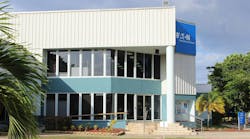The end of the Cold War and the resulting military drawdown created a new battle for the U.S. Air Force - fighting shrinking budgets - particularly its own energy costs. As a result, Hill Air Force Base (HAFB), a large industrial complex near Ogden, Utah, is receiving an extensive systems upgrade over five years from CES/Way International, a comprehensive energy-services company (ESCO) based in Houston, Texas.
HAFB contracted with CES/Way International to complete energy savings projects, which will reduce its utility bill of approximately $14 million annually, the state's second largest.
The facility's 1,400 structures, some illuminated 24 hours a day, total more than 12.4 million square feet. It's currently one of five Air Force Material Command Centers with extensive repair facilities where F-16 fighters and C-130 cargo planes are overhauled. Because of the large size and complexity of the base-wide energy conservation project, it's being implemented in phases over five years as part of an 18-year energy savings performance contract.
So far, annual energy savings from lighting upgrades in 30 buildings total $445,500. A hospital retrofit saved $485,650 in its first six months. Relighting a repair hanger will save $140,177 a year.
As an ESCO, CEW/Way works in conjunction with HAFB's electrical utility provider, Utah Power and Light, on other projects in the utility's service area. Because of its ongoing relationship with the utility, the company was able to offer HAFB approximately $2.3 million in utility rebates in conjunction with the overall retrofit projects.
Another part of the overall upgrade of the air base consisted of lighting retrofits in an additional 49 buildings, plus base-wide steam system repairs and mechanical retrofits in two buildings, all totaling $2,385,400. The lighting retrofits included installing new energy efficient lamps and electronic ballasts.
Advanced technology was in the spotlight in the lighting upgrade of a large aircraft repair hanger. This was a U.S. Department of Energy (DOE) Demonstration Project of extremely bright (135,000 lumens) electrodeless sulfur lamps connected to light pipes and downlight fixtures in what is said to be the world's largest installation of the new sulfur lighting technology. The performance contractor volunteered its lighting expertise to apply the new technology to solve the hangar's low light problem.
Besides saving energy, the new lighting systems at the air base also help save the environment. Because fewer kilowatts need to be generated by the power plant, less pollution is created. For example, U.S. Environmental Protection Agency (EPA) calculations show that the 3,700,000 kilowatt-hours saved by just the sulfur lamp upgrade will prevent the annual emission of more than 4,000 tons of carbon dioxide, 13 tons of nitrogen oxide and 13.5 tons of sulfur dioxide into the air. And, the thousands of replaced lamps containing mercury and ballasts containing toxic PCBs, were properly disposed of by an EPA-licensed contractor.
CES/Way International, a Sempra Energy Solutions Co., and a member of an energy-efficiency program led by Advance Transformer Co., Rosemont, Ill., also is assisting HAFB's energy conservation initiatives by recommending changes in operation procedures so that equipment runs only when needed, and high-energy-consumption tasks are scheduled for off-peak hours when electricity charges are lower.
The HAFB project earned a U.S. Environmental Projection Agency's Green Lights Award. The project is a benchmark for implementing the U.S. DOE's Federal Energy Management Program to use Energy Saving Performance Contracting throughout the federal government.








